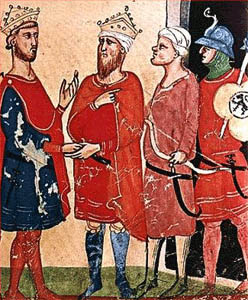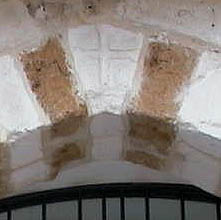STORIES
FROM OUR HISTORY
Brindisi
during the Ages of the Crusaders
2th part
The Fifth Crusade:
During the fifth Crusade (1217-1221), Brindisi and Messina
were the meeting places and starting harbours to the
Holy Lands for the European Armies. Pope Innocent III,
who planned for the crusaders to meet in Brindisi in
1216, promised an indulgence to every Crusader, including
those who simply helped to pay the expenses but did
not go on the Crusade themselves.
Saint Francis of Assisi probably
arrived in Brindisi by ship after his pilgrimages to
Egypt and the Holy Land during 1219 and 1220, where
he tried to convert the sultan Melek-el-Kamel.
Legends say that "Saint Francis, after walking
for the whole day through the Medieval small streets
of Brindisi, praying and talking of peace, until the
dusk of the evening; he had to rest his body and decided
to stay in the 'Casale' area around the Bizantine Chapel.
The morning after, he noted that a spider web was hiding
the image of Our Lady on the wall, so Francis humbly
talked with 'brother spider' so that it ate its web,
unveiling back the holy image".
During 1215 the presence of the blessed franciscan monk
Egidio of Assisi with a brother monk is certain
and documented; the monks stayed in Brindisi for some
time waiting for embarkation.

Crusaders embarked for Palestine.
(XV century)
From the harbour of
Brindisi, Peter II of Courtenay, consecrated
emperor of the Latin Empire of Constantinople by the
Pope, set sail in 1217 with his "weak army"
and Venetian fleet, to conquer Durazzo, but after an
"unlucky sail" he was defeated and was jailed
on his eastward journey, and died in confinement.
During the month of
September, 1218, a fleet of Crusaders, fitted out by
the Pope Honorius III at a cost of 20 thousand "silver
marks", after being in Brindisi for 12 months finally
set sail and left for Cyprus by order of the papal
legate Pelagius.
Frederick II, crowned as Holy Roman Emperor at his papal
coronation in 1220, was in Brindisi in March 1221, from
where he sent a fleet of forty well equipped ships to
Damietta, but this Egyptian campaign failed pitifully
because of the defeat of September 8th, 1221.
Frederick II and
the sixth Crusade:
 In
January 1224 the marquis William VI of Montferrat
came to Brindisi and here left his army to go and meet
Frederick II in Sicily, in order to ask support before
his departure to Thessaloniki that was under siege by
Theodore Comnenus Ducas. In
January 1224 the marquis William VI of Montferrat
came to Brindisi and here left his army to go and meet
Frederick II in Sicily, in order to ask support before
his departure to Thessaloniki that was under siege by
Theodore Comnenus Ducas.
On November 9th, 1225, in Brindisi's Cathedral, Frederick
II married Yolande (Isabel) of Brienne, heiress
to the Kingdom of Jerusalem, and immediately took steps
to assume control of the Kingdom from his new father-in-law,
John of Brienne.
After several postponements,
the Emperor organized the Crusade which for a long time
had been promised to the Pope. On 1227 Brindisi was
the meeting point for thousands of Crusaders coming
from all over Europe; it was the most important period
for the Town during its participation to Crusades.
Fifty ships were laying ready in the harbour but they
were not enough for all the soldiers; water and food
were scarce and, together with the summer heat, an epidemic
caused the death of many crusaders; tens of thousands
of people escaped from the infected camps and scattered
around Italy. In the cemetery near St. Martin hospital
(photo)
many crusaders, dead because of this plague, were buried.
The Emperor himself caught the plague, postponing the
Crusade till after his complete recovery.
The Pope did not believe this information, and due to
this the Emperor was excommunicated.
The actual beginning
of sixth Crusade, the only one entirely embarked from
Brindisi, happened on June 28th, 1228. The Crusade was
ended with the pacific agreement on February 1229 with
sultan Malik al-Kamil (Jaffa treaty): the Emperor negotiated
with the Muslims to obtain a kingdom comprising Jerusalem,
Bethlehem, Nazareth and the adjoining littoral for a
period of ten years.
On June 10th, 1229, Frederick II went back to Brindisi,
and from here he took back command of the Kingdom of
the South of Italy, defeating the Pope's troops who
during that time took advantage of the emperor's absence
by attacking his Italian colony.
The Knights Orders:
 The
Knights Hospitaller also known as Knights of Rhodes,
Knights of Malta, and the Order of St. John of Jerusalem,
were in Brindisi since 1156, at the home of St. John
"de Hospitale" and afterwards at the Church
of St. John of Greeks. Nowadays the building is named
"Tourist's House" (photo). The
Knights Hospitaller also known as Knights of Rhodes,
Knights of Malta, and the Order of St. John of Jerusalem,
were in Brindisi since 1156, at the home of St. John
"de Hospitale" and afterwards at the Church
of St. John of Greeks. Nowadays the building is named
"Tourist's House" (photo).
The presence of Knights Templar appears to date from
1196. The location of their "Domus" (the Templar's
residence), that enclosed St. George Temple church,
is not yet well known; for some local historians, it
was near the current placement of railway station, for
others it was near the Temple of St. John Sepulchre
(more
info).
The Seventh Crusade
The last chapter in the times of the crusaders which
involved the city of Brindisi was the landing of King
Louis IX of France during the seventh Crusade (1248-1254),
remembered by the local tradition with the festivity
of "Adorned Horse" - the procession
of Corpus Domini, with the Bishop riding an adorned
white horse (more
info).
Images
(from the top):
- Crusaders embarked
for Palestine. (XV century)
- Frederick II with the sultan Malik al Kamil
- Templar Cross (portal of Tourist's House)
Use of reproductions in any form,
be it text or photographs from this page, have to be
authorized by the author
|
Bibliography:
-
Rosanna Alaggio - Natura,
santi e sovrani. Brindisi nel Medioevo,
Tesi di dottorato di ricerca in Storia medievale,
Università degli studi di Palermo,
2002 (
web)
-
Ernst Hartwig Kantorowicz,
Federico II, imperatore, Milano 1978
-
Vittorio Stano –
da Le Origini del Santuario di Jaddico.
( web)
Fulvio Bramato, Itinerari crociati in terra
d'Otranto. Documenti, monumenti, tradizioni.
La via Traiana, in Verso Gerusalemme
(Atti del II Convegno internazionale nel IX
centenario della prima crociata - Bari, 11-13
gennaio 1999), a cura di F. Cardini - M. Belloli
- B. Vetere, Lecce 2001 - ( web)
-
Giacomo Carito, Brindisi
in età sveva, in Federico II
e Terra d'Otranto (Atti del secondo convegno
nazionale di ricerca storica, Brindisi 16-17
dicembre 1994) Brindisi 2000
|
|
| Correlated
documents:
» The
Adorned Horse (procession of Corpus Domini)
» Temple
of St. John Sepulchre |
|
«
Back
|

